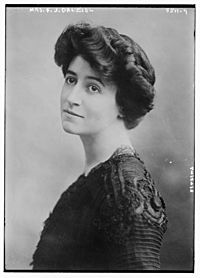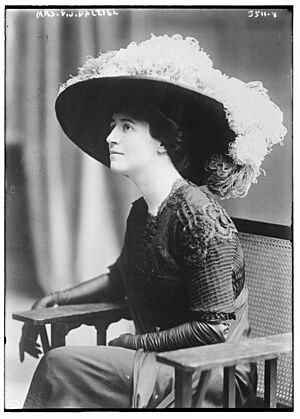Emily Hoffman facts for kids
Quick facts for kids
Emily Hoffman
|
|
|---|---|

Hoffman in 1900
|
|
| Born |
Emily Key Hoffman
1876 New York City, New York, U.S.
|
| Died | September 12, 1927 (aged 50–51) Nantucket, Massachusetts, U.S.
|
| Education | Brearley School |
| Occupation | socialite, dancer, sportswoman |
| Spouse(s) |
Frederick Young Dalziel
(m. 1901) |
| Children | 2, including Diana Vreeland |
| Relatives | Philip Barton Key (great-grandfather) |
Emily Key Hoffman (1876 – September 12, 1927) was an American socialite, dancer, and big-game hunter. When she got married, she became known as Mrs. F. Y. Dalziel.
She was a very important young woman during the Gilded Age, a time in American history (roughly 1870s-1900) when there was a lot of wealth and fancy parties. Emily was a leading figure in the high society of New York and Newport, Rhode Island.
Emily was also a talented dancer. She performed Spanish dances at many social events. People called her "the Carmencita of New York society." In 1900, one of her performances at the Waldorf-Astoria Hotel was so good that she got a standing ovation. She was even asked to perform on Broadway, but she said no. This was because women from her social class were expected to behave in certain ways.
After marrying British financier Frederick Young Dalziel in 1901, Emily lived in Paris for a while. She returned to the United States before World War I started. She loved hunting big animals and went on trips in the Western United States and East Africa. She hunted grizzly bears, lions, rhinoceroses, and hippopotamuses. Once, a rhinoceros almost attacked her, but her friend, Sir Charles Ross, 9th Baronet, saved her by shooting the animal.
Emily Hoffman was the mother of Diana Vreeland, who became a famous editor for Vogue magazine.
Early Life and Family
Emily Key Hoffman was born in 1876. Her parents were George H. Hoffmann, a lawyer, and Mary Martin Ellis. Both of her parents came from important families in Virginia and Maryland.
Her father's family, the Key family of Maryland, included her cousin Francis Scott Key, who wrote "The Star-Spangled Banner." Her great-grandfather was Philip Barton Key, a chief justice and U.S. congressman. Her great-great grandfather was Governor George Plater of Maryland. On her mother's side, Emily was related to the Washington family, as she was a descendant of one of George Washington's brothers. Her grandfather, John Washington Ellis, became rich in the dry goods business and helped start the First National Bank of Cincinnati.
Emily's family was part of "The Four Hundred," a special group of the most important families in New York high society during the Gilded Age. In 1886, their family was added to the Social Register, which was a list of socially prominent families.
Emily grew up with a lot of wealth. Her family lived in a large home in Manhattan, New York City, and had a summer "cottage" called Stone Acre in Newport, Rhode Island. Her grandfather built this summer home in 1882. Emily's father passed away in 1885, and her mother raised her. When she was sixteen, Emily went to Brearley School to finish her education.
Adult Life
In 1895, newspapers said that Emily was "the most beautiful young lady" at a fancy ball in Newport. She officially joined New York society as a debutante in 1896. After her formal debut, she was known as one of the "most beautiful Belles of Newport." Emily was very popular during the social season. She was invited to many dinner parties and dances, including Mrs. Astor's famous annual ball.
A Swiss artist named Adolfo Müller-Ury painted a portrait of Emily. In the painting, she looked like the Madonna, which led to her being called the "Madonna of the 400." This painting was shown in a gallery in New York City in 1897.
In 1898, Emily traveled to Rome, Italy, where she was also very popular. Emily was a sportswoman who enjoyed hunting, riding horses, and playing tennis. She was also a very good dancer. She was famous in high society for her Spanish dances and was called "the Carmencita of New York society." She was especially known for her performances of the cachucha dance. In January 1900, she performed at the Waldorf-Astoria Hotel and received a standing ovation. She got fan mail and great reviews in the newspapers. She was even offered a chance to perform her dances on Broadway, but she turned it down. This was because women of her social standing were not expected to become professional performers.
Unlike some other American debutantes who were encouraged to marry European noblemen, Emily seemed more interested in her own life. In 1899, she joined a group of people called the Carbonites, who were known for their free-spirited ways.
In November 1900, Emily sailed to the Mediterranean Sea on a yacht. In September 1901, she became engaged to Frederick Young Dalziel, a Scottish stockbroker. Even though he went to Oxford, her mother was not happy because he was from a lower social class. On September 28, 1901, Emily married Frederick in London. They spent their honeymoon in the South of France.
Emily and Frederick had two daughters: Diana Vreeland, who became a famous editor for Vogue, and Alexandra, who married Sir Alexander Davenport Kinloch, 12th Baronet. Emily inherited money from both of her parents. She and her family lived abroad, mostly in London and Paris. When World War I began, they moved back to the United States and lived in a townhouse in Manhattan.
Emily was a skilled big-game hunter. She went on trips to the American Old West to hunt grizzly bears and to Africa to hunt exotic animals. In 1921, she returned from East Africa with many hunting trophies, including an elephant, two rhinoceroses, seven lions, and three hippopotamuses. On another hunting trip in Africa, a rhinoceros charged at her. She was saved when her friend, Sir Charles Ross, 9th Baronet, shot and killed the animal.
Emily Hoffman died from pneumonia on September 12, 1927.


